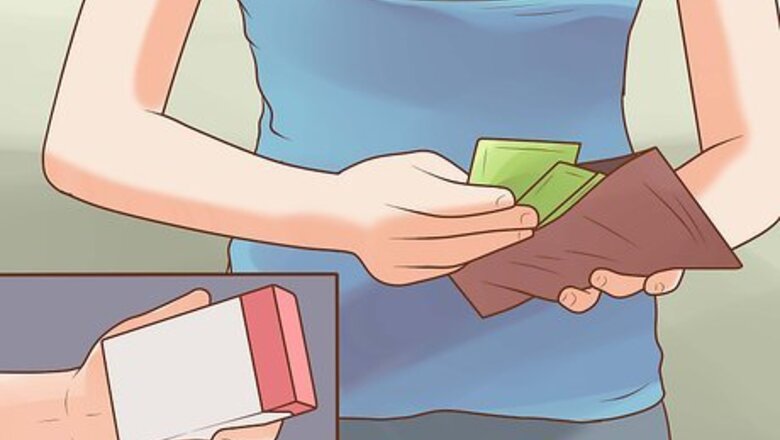
views
Smoking Cigarettes
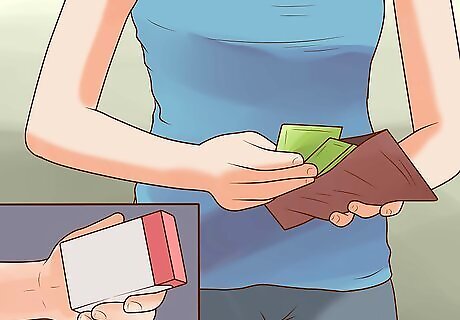
Buy a pack of cigarettes. If you look young enough, get ready to present a government-issued ID when buying a pack. There are many different kinds of cigarettes, so choose which kind you want carefully. In 2019, the United States federal government raised the national minimum age to purchase tobacco from 18 to 21. It also includes all products that contain nicotine such as vape pens (e-liquid), chewable tobacco, cigars, hookahs, etc. The minimum age will vary by country, check with your local laws. The two most widely available types of flavored cigarettes are mentholated cigarettes, which have a minty flavor, and clove cigarettes, which are flavored with, unsurprisingly, cloves. In specialty shops, you can find cigarettes with a wider variety of flavors, from chocolate to cherry. Filtered cigarettes have a filter that reduces the amount of nicotine and tar delivered to the lungs with each inhalation, making them safer to smoke than unfiltered cigarettes. Unfiltered cigarettes are easier to inhale because you don't have to pull through the filter, but if you are new to smoking, you should not start on them, as they might make your throat burn. Unfiltered cigarettes are also more harmful to health than filtered cigarettes, though all cigarettes are dangerous. Light and ultra-light cigarettes are deceptively named. Some people believe them to be safer than regular cigarettes, but this is not the case. The main difference between full flavor, light, and ultra-light cigarettes will be taste. If you are new to smoking, you might start on ultra-lights and work your way up to a fuller flavor.
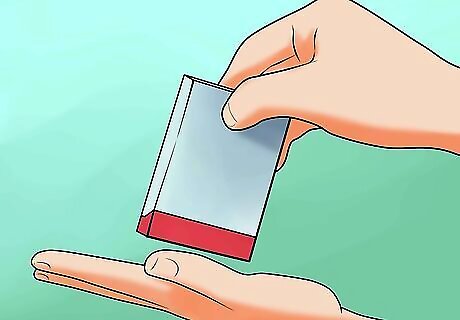
Pack your cigarettes. Packing your cigarettes condenses the tobacco in each cigarette, making it burn slower and intensifying the flavor. You may have to inhale slightly harder if you pack your cigarettes, so you might skip this step if you have trouble inhaling without coughing. Turn the pack upside down so the opening from which you remove the cigarettes is facing downward. Extend your free hand palm up. Rap the top of the pack down on the fleshy, flat part of your palm three times, hard. Rotate the pack (still upside down) by 180 degrees. Repeat the process to make sure cigarettes on both sides of the box are equally packed.
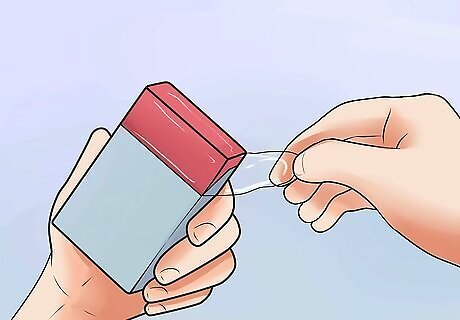
Open the pack. Cigarettes come with a plastic cover that will have a small pull tab around where the lid flips open. Pull that tab to break the plastic seal. Remove the foil that covers the cigarettes. In the boxes for some brands, such as Camels, both foil tabs pull away, and in other brands, such as Marlboros, only the front tab pulls away.
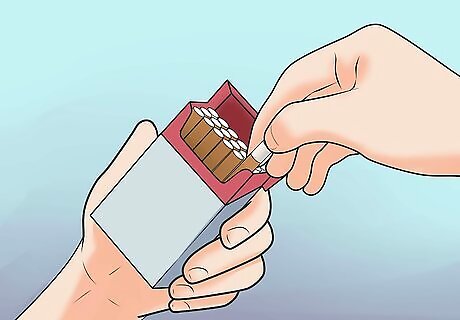
Flip your lucky. This is an optional step, but many smokers flip a single cigarette in the box upside down and designate it as their "lucky" cigarette. This is the last cigarette they smoke in the pack. Although there is no rule as to which cigarette should be the lucky, most people who flip a lucky always choose the same cigarette position — for example, the second cigarette from the left in the back row. Although the cigarette is called a "lucky," in practice, it's an excuse to not give away your last cigarette to friends trying to bum a smoke. Just say "sorry, this one's my luck."
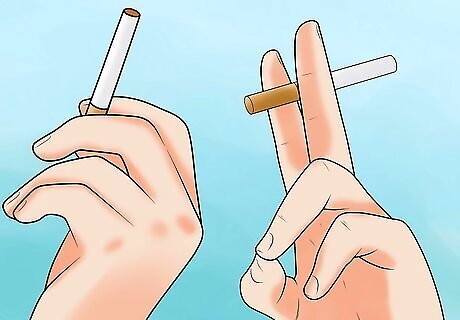
Hold the cigarette with the filter pointing back toward your body. There are a couple of different ways to hold a cigarette, so experiment with it until you find a style that feels comfortable and natural for you. The most common method is to hold the cigarette stable between your index and middle finger. The filter should be between the first knuckles on each finger. Many people simply hold the cigarette between their thumb and forefinger as though it were a pencil. In this case, the filter should be against the pads of your fingers.
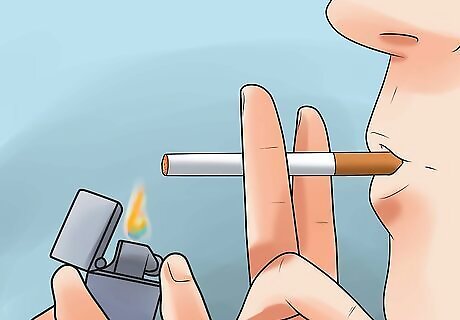
Use matches or a lighter to light the cigarette. With the filtered end of the cigarette between your lips, put a flame to the exposed end while inhaling. Inhale deeply two or three times while the flame is touching the exposed end to ensure the cigarette has been properly lit. After lighting the cigarette, look down at the lit end to make sure the entire end has been lit. If one corner remains unlit, repeat the process. If the wind blows out your flame, create a shelter with your free hand around the cigarette. If the wind is so strong that your hand cannot block the wind, turn so that your back is to the wind. Allow your head to block the wind while keeping your free hand around the flame. People with long hair should be careful because the wind can blow your hair into the flame. Because a lighter has a more stable flame, start with a lighter if you're a new smoker. Matches burn down quickly and might burn your hands if you take too long.
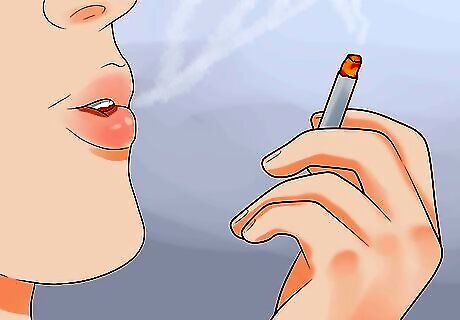
Inhale and exhale your cigarette. At first, you'll want to take shallow inhalations, because deep inhalations might result in burning coughing fits. As you get used to smoking, you'll be able to take deeper drags. You should be sucking the smoke into your lungs, not holding it in your mouth. Exhale through your mouth — or your nose if you're feeling fancy. A good way to tell if you're drawing the breath into your lungs or mouth is to try to exhale through your nose. If no smoke comes out of your nose, you're holding the smoke in your mouth. Don't hold the smoke in your lungs for longer than feels comfortable. This is supposed to be a pleasurable process. It's fine to smoke your cigarette all the way down to the filter, but don't let the fire actually touch the filter. It smells and tastes awful.
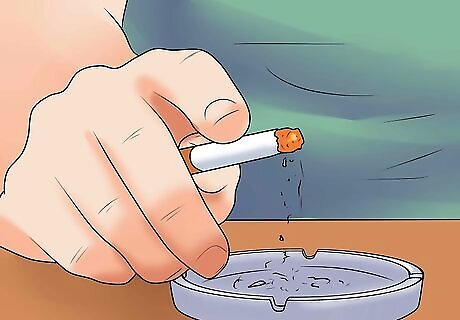
Remember to ash your cigarette. As the cigarette begins to burn down, it will turn to ash. Tap on the top of the cigarette with your index finger to jar the ash loose from the end of the cigarette and drop it into an ashtray. If you don't remember to ash from time to time, the ash might fall on your clothes or into your food or drink. You can also tap the end of the cigarette against an object — like an ashtray — to remove the ash. Cigarette ashes can temporarily smear on your clothes. Put out your cigarette's flame. When you've finished smoking, make sure you extinguish the flame from the cigarette. In drier parts of the world, fires could easily be started by lit cigarettes that have been improperly disposed of. There are several methods for putting out a cigarette. Stubbing out a cigarette means pressing it into a flat surface until it stops burning. You can just tamp it multiple times into the ashtray until it stops glowing. You can also drop it to the ground and grind the flame out with your shoe. Note that this will leave a black charred mark on the ground. Pick up the cigarette and throw it away in a trash can. If you don't have an ashtray, but don't want to create a large black smear by grinding the cigarette out with your shoe, you can pop the cherry. This means to flick the cigarette until the flaming part at its tip dislodges and falls out of the cigarette. You can grind the cherry out with less smearing this way. Dispose of the cigarette in a trash can.
Smoking Cigars
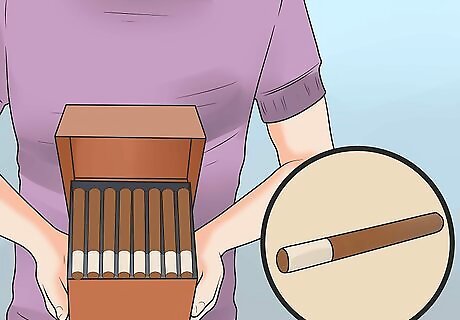
Buy a cigar. Just like cigarettes and all other nicotine products, you must be at least 21 to purchase cigars, so bring your ID with you. There are many different types of cigars, and varying quality, so do your research before buying one. Most cigars are corona cigars, which are usually from South America. They're 5.5 to 6 inches long and have a ring gauge (diameter measured in units of 1/64th of an inch) between 42 and 45. Panatela cigars are longer and thinner than coronas and are more popular with women because of their feminine shape. Lonsdale cigars are 6 to 7 inches long with a ring gauge of 42 to 47. They're a good beginners' cigar. Churchill cigars (also known as Julie tas) are long and thick, with a length of 7 inches and a ring gauge of 47. These are recommended for more experienced cigar smokers. Robusto cigars are Cuban, with a length of 5 inches and a ring gauge of 50, and are known for their strength and flavor. Torpedo cigars are shaped like a torpedo, coming to a point at the end. These cigars take at least an hour to smoke, so should be enjoyed while relaxing for a long period of time. The shorter and wider a cigar is, the more intense it will be, so beginners should choose a longer, thinner variety to avoid coughing fits.
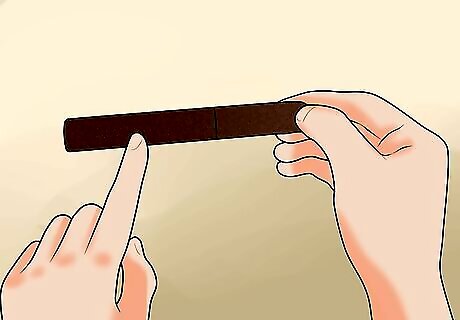
Check the cigar for consistent packing. Before purchasing the cigar, lightly squeeze it all along its length to make sure there are no particularly hard or soft spots. That would suggest the tobacco has been unevenly packed, and that the cigar would be difficult to smoke. Also, check for any discolorations you might find.
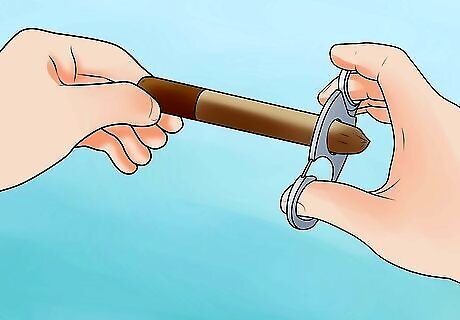
Cut the cigar. To keep the tobacco from drying out, cigars have a cap on the end that must be removed before you can smoke them. If you have a cigar cutter, place the tip of the cap-end of the cigar into the cutting hole. Cut it off with one strong, swift chop. If you don't have a cigar cutter, use sharp scissors or a knife to remove the cap. Don't use dull blades or apply weak pressure because that will squeeze down on the cigar and change its shape. This will make it harder and less pleasant to smoke. Be very careful not to cut yourself when working with any of these sharp-bladed tools.
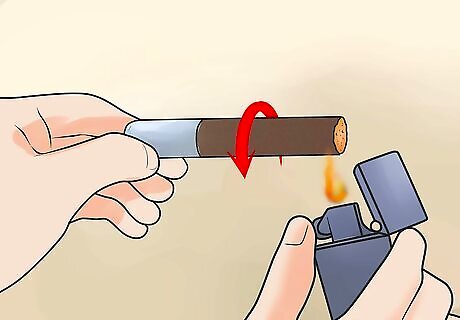
Warm the cigar before lighting it. Hold the end that will be lit over an open flame for a few seconds, rotating it to make sure that the heat is evenly applied to the cigar. Warming up the cigar in this way will make it easier to light.

Light the cigar. Hold the flame to the tip of the cigar while sucking through the unlit end. Don't inhale the smoke, just draw it into your mouth. Make sure the cigar is fully lit before putting our lighter away. Blow on the lit end of the cigar to make sure it is fully lit. The air from your breath will make the lit parts glow brighter, and you'll be able to see if there are any unlit spots.
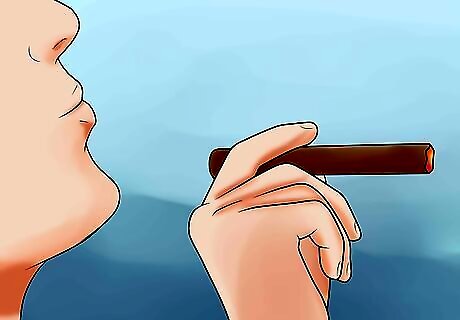
Inhale and exhale the cigar. Unlike cigarettes, you do not inhale cigar smoke into your lungs. You simply pull the smoke into your mouth, where you hold it for a few seconds to enjoy the taste. Remember that cigars can take an hour or more to smoke, so don't try to speed-smoke it! Set aside a good portion of time to savor the experience. If you get distracted and don't puff on the cigar from time to time, to risk letting it go out. Make sure to puff every thirty seconds or so to keep it lit.
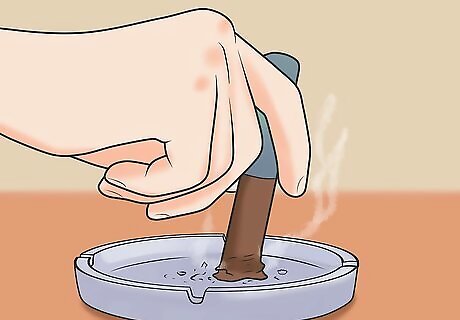
When you're finished smoking, put out the cigar. Stub the cigar out in an ashtray or on the ground, though note that it will leave a black smudge wherever it is extinguished. If you didn't smoke much of it and wish to save it for later, don't stub it out. A cigar that's been re-lit after being stubbed out will taste awful. Cut the lit end off with the cigar cutter and let that flame die. The remaining cigar will still have a burnt taste when re-lit, but not nearly as bad as a stubbed out cigar.
Smoking a Pipe
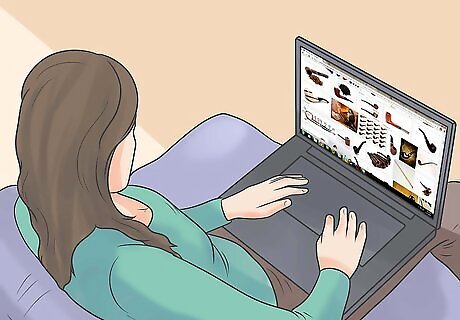
Buy a pipe and pipe tamper. Both of these products can be bought at a tobacconist or online. A tamper is used to pack the tobacco down into the bowl. There are a few things you should consider when making your pipe purchase: Make sure you like the way your pipe looks. Browse through all the options at the tobacconist or online and make sure you buy a product you'll want to use time and again. Choose a pipe that has a smooth airway from the mouthpiece into the hole, to ensure a smooth smoking experience. Avoid metal filters in the pipe, as they cause condensation that affects the flavor of the tobacco
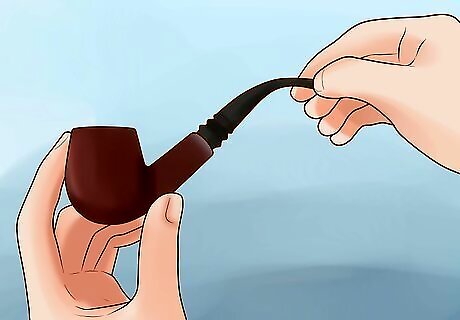
Buy the right tobacco. There are many different types of tobacco, and you might get overwhelmed trying to make a decision if you're not familiar with all your options. The best thing you can do is ask a tobacconist for a recommendation — they'll be able to talk you through the process and match you with tobacco that best suits your tastes. In general though, here are some types of tobacco you might find at a tobacconist: English and Scottish-style cake tobaccos tend to be spicy and full-flavored American-style flavored tobacco is sometimes flavored with sugars or syrups to change the taste. Cavendish is a cured tobacco flavored with licorice and vanilla. Your best bet is to ask a store employee for recommendations, just like you would ask for a sommelier for wine recommendations.
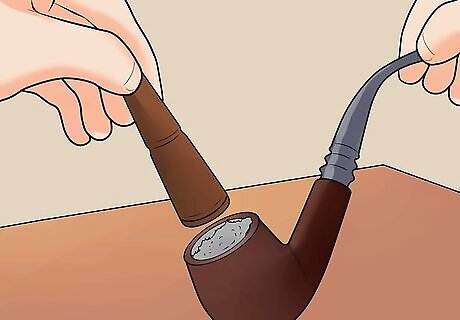
Pack your pipe. Pour your tobacco into the bowl of the pipe until it is full, then use your tamper to lightly pack it down until it only half-fills the bowl. Repeat that process of filling and tamping until the bowl has been filled with tightly packed tobacco. Make sure you don't pack it too tightly, or else it will be difficult to draw air through to smoke the pipe. The tobacco should be slightly springy when you press down on it.
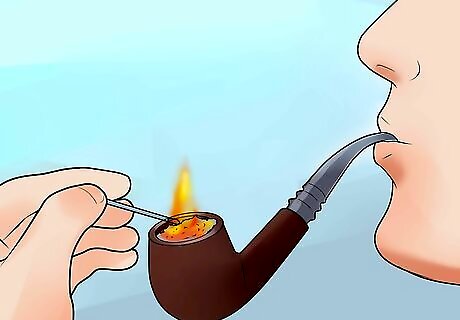
Light the pipe. Using a match or lighter, hold the flame over the bowl while gently inhaling through the mouthpiece. Move the flame over the bowl to evenly distribute the heat throughout the tobacco. After your initial lighting, gently tamp the tobacco again, then repeat the process.
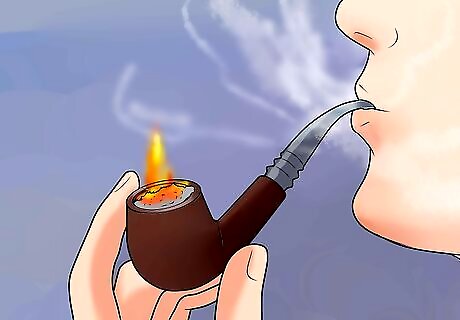
Inhale and exhale. Like with cigars, pipe smoke is not meant to be inhaled into the lungs but held in the mouth to enjoy the flavor. Tamp the tobacco down from time to time to make sure it stayed densely packed in the bowl. If you feel the moisture being sucked back into your mouth through the mouthpiece, insert a pipe cleaner for a few moments to dry out the passageway. If your pipe grows too hot, let it go out and cool down. You can always relight the tobacco.
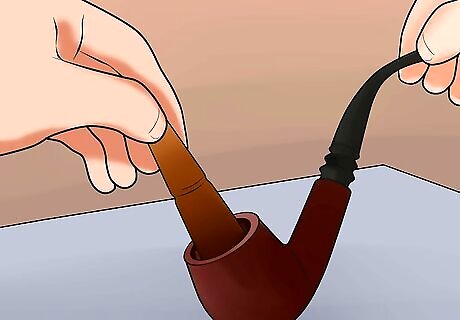
Put out your pipe. When you've finished smoking, you can either put out the smoke by pressing your tamper into the bowl until it is extinguished, or by simply letting the pipe sit unsmoked until it dies on its own.

















Comments
0 comment